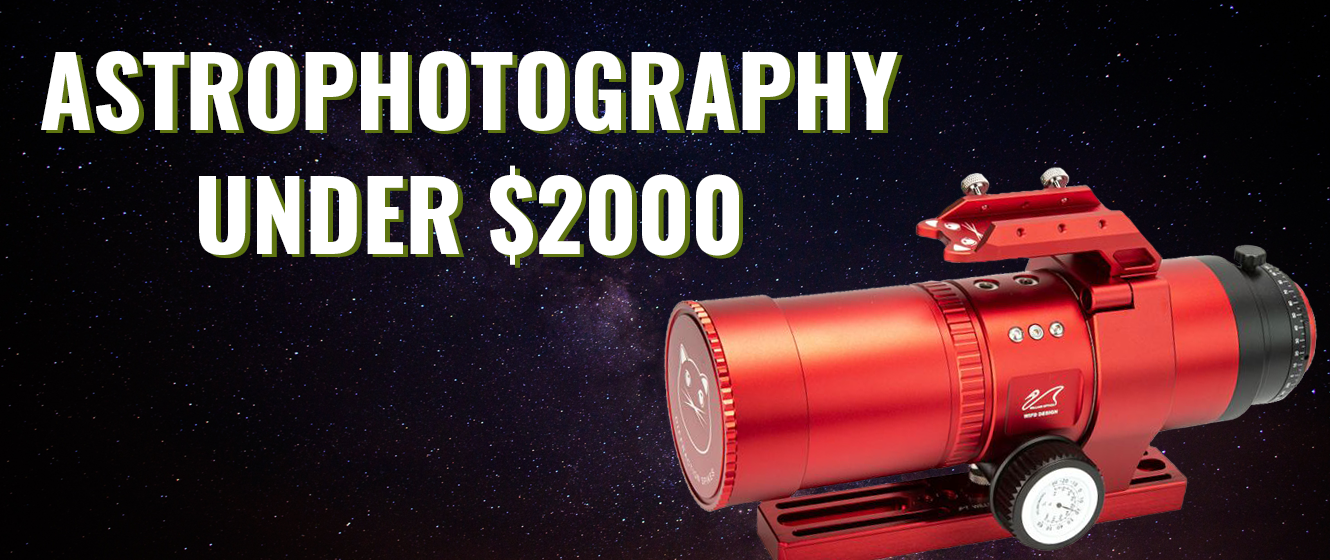
Astrophotography is one of the most intimate ways we as human beings can truly engage with the beautiful universe in which we live. Through astrophotography, you can capture beautiful nebulae and galaxies billions of light-years away from the Earth using your own gear. However, astrophotography can be a daunting and challenging prospect. In addition, it can get quite expensive. Let’s go over some different combinations of gear you can buy for under $2,000 that will allow you to capture images of the universe.
OPTION #1: Wide-field Deep Sky Astrophotography
1. Sky-Watcher Star Adventurer 2i Pro Pack -
Astrophotography really requires some sort of tracking mount. Ideally, you want to purchase an equatorial mount that can align with the north celestial pole (NCP). That way, your mount only needs to rotate on one axis to be able to track the sky. This prevents what’s known as “Field of View” rotation.
So, are you looking for a portable astrophotography mount that’s easy to use? We recommend a portable star tracker like the Sky-Watcher Star Adventurer or iOptron SkyGuider Pro. These trackers can support the weight of a small refractor & camera without any issue. Simply align with the north celestial pole, turn the tracker on, and point towards your object of choice. Be aware that many of these mounts do not come with full GoTo, so having some understanding of where objects are in the night sky will be helpful.
Alternate Suggestion: iOptron SkyGuider Pro -
2. RedCat 51 Gen 3 APO f/4.9 Telescope w/ WIFD -
William Optics' newest generation of the popular RedCat series, the RedCat 51 APO WIFD, is a fantastic telescope for widefield imaging. This telescope is designed as a “petzval”, meaning that it does not require any additional field flatteners to achieve round stars across the entire field of view. The inclusion of the William Optics Internal Focuser (WIFD) delivers smooth focusing, a steady mount for your imaging equipment, and is EAF ready! With a focal length of 250mm and a weight of only 4 lbs, this would work well with a Sky-Watcher Star Adventurer or similar portable equatorial mount and camera. Additionally, you should be able to take up to 60” exposures with this telescope on any of the popular portable mounts without any autoguiding.
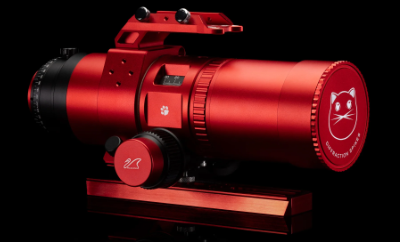
Alternate Suggestion: Apertura 60EDR with 2” field flattener -
Those looking for a little more aperture and focal length at a slightly lower price point might be interested in the Apertura 60 EDR. Unlike the RedCat 51, the Apertura 60 EDR can also support eyepieces for general astronomy. However, the downside is that the Apertura 60 EDR is only a “doublet” refractor. To learn more about the difference between a doublet and a petzval refractor, we recommend checking out our article on Beginner’s Guide to Refractors. The Apertura 60EDR also weighs more than the RedCat 51, and it might be difficult to balance this telescope without additional counterweights or an extension bar. The longer focal length also makes this telescope more susceptible to guiding errors, and you might find it difficult to take anything more than 30” exposures without autoguiding.
3. ZWO ASI294MC Astronomy Camera-
A great astrophotography camera to use with this setup is the ZWO ASI 294MC uncooled color camera (or camera with a similar-sized chip). This differs from the cooled version as it does not have a built-in cooler to help regulate the temperature of the sensor. However, you’ll still have the same field-of-view and sensor with the popular cooled variant, but at a lower cost. With this camera, the Star Adventurer 2i, and the RedCat 51 WIFD, you should easily be able to achieve 60-90” exposures before stars begin to show “streaks” as a result of periodic error, provided you have good polar alignment.
With the ZWO ASI294MC, RedCat 51, and Sky-Watcher Star Adventurer combo, you’ll be able to take beautiful photographs of the Andromeda Galaxy (M31), Orion Nebula (M42), Rosette Nebula, and so many more objects with a large angular size in the night sky.
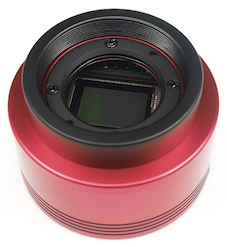
Alternate Suggestion: QHY183C Astrophotography Camera-
Although the same price as the ZWO ASI294MC, this camera has a slightly smaller sensor. This means the overall field of view will be smaller. That being said, it does come with one major upside: cooling. As we mentioned earlier, some deep sky cameras come with a built-in cooler to help regulate the temperature of the sensor. This is helpful when creating calibration frames, especially dark frames. Additionally, a cooled sensor helps reduce thermal noise, which results in images that are less noisy than on an uncooled sensor.
Option #2 - Planetary & Lunar Astrophotography
1. Celestron Advanced VX Equatorial Mount -
Looking for something that’s a little larger? We recommend checking out the Celestron Advanced VX Equatorial Mount. Having a sturdy, stable equatorial mount is absolutely essential if you’re looking to do something with a large telescope to get good images of the moon & planets. The Celestron Advanced VX will easily be able to support telescopes up to 8” in diameter for planetary & lunar astrophotography.
2. Celestron Omni XLT 150 OTA -
The Celestron Omni XLT 150 optical tube assembly (OTA) is a 6” reflector that comes with a focal length of 750mm. At f/5, this makes this telescope a decent option for planetary and lunar imaging, and it can be used with a Celestron AVX. It’s large enough to really bring in some beautiful images of the planets, while not being large enough to particularly tax your mount or being too heavy to bring outside. Provided you have good collimation, you’ll be able to take beautiful photos of the rings of Saturn, the cloud belts of Jupiter, and more.
Image: Simulated field of view of the NextImage 10 with a 750mm telescope. Image Credit: Astronomy.tools
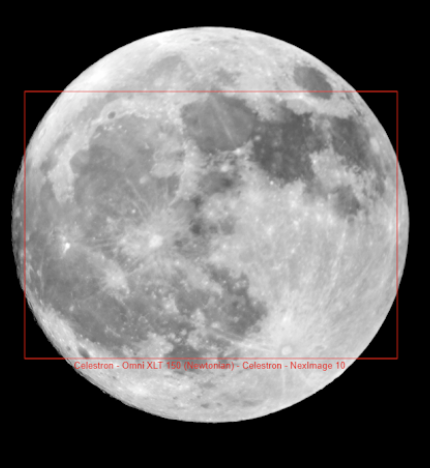
3. Celestron NexImage 10MP Solar System Imager -
A fairly simple yet capable planetary imaging camera, the Celestron NexImage 10MP camera is a popular choice for beginner astrophotographers. This camera works with USB 3.0 ports, comes with a 10 megapixel sensor, captures up to 200+ frames a second, and works with most astrophotography software (Celestron iCap is included with the purchase). With the Celestron Omni XLT 150mm OTA, you’ll be able to take stunning photos of the Moon, while also being able to capture detail on the planets.
4. Apertura 5x APO 1.25” Barlow Lens -
To capture significantly more detail on the planets with a NexImage 10 MP camera, we strongly recommend some sort of Barlow lens. A Barlow lens acts to increase the focal length of the telescope. This, in turn, will dramatically increase the magnification of your telescope. The Apertura 5x APO 1.25” Barlow lens turns the 750mm telescope into a whopping 3750mm telescope, resulting in amazing photographs of the planets. Looking for details about how to process your planetary astrophotography? Check out our video on processing planetary astrophotography.
Image: Simulated field of view of the NextImage 10 with a 750mm telescope and a 5x barlow. Image Credit: Astronomy.tools
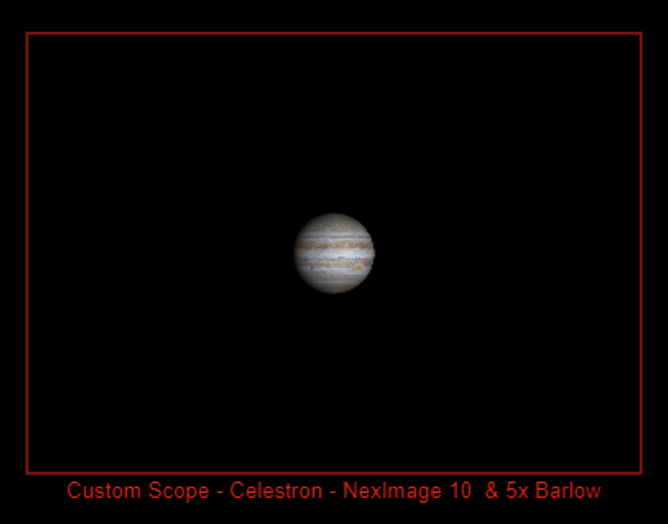
Option #3 - Buying Used
Buying used is always a great option to maximize the amount of gear for your buck. Buying used telescopes, mounts, and cameras can save you many thousands of dollars with little sacrifice as far as your image quality goes. At High Point Scientific, we offer used telescopes, cameras, and mounts that are great for amateur astronomers who are watching their budget. Open box gear, demo equipment, and some refurbished telescopes that include the full manufacturer’s warranty. Other telescopes in excellent, fair, or good condition come with a full High Point Scientific 90 Day Warranty!
This Article was Last Updated on 7/12/2024

Learn More
Interested in learning more about building your astrophotography setup? Not sure where to begin? Check out our Astronomy Hub!


















